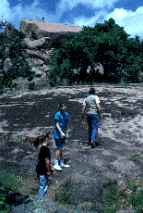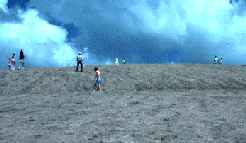ENCHANTED ROCK: THE HAUNTED MOUNTAIN OF TEXAS
by John Bigley and Paris PermenterEnchanted Rock looms over the Texas hillcountry like a massive bald mountain, an enormous dome of pink granite that rises 325 feet above the small stream flowing at its base. Covering over a square mile, the formation is second in size only to Georgia's Stone Mountain. Over the years, rumors about the rock have been plentiful: it glows in the dark, human sacrifices were held on its smooth granite surface, it moans at night, it hides veins of gold and diamonds, and it is haunted. Everything about the rock, from its name to its legends, is enchanted.

Enchanted Rock rises 325 feet above the Texas Hill Country.
PHOTO CREDIT: PARIS PERMENTER & JOHN BIGLEY
Enchanted Rock State Park is located north of Fredericksburg in the heart of the Hill Country. The land here is covered with live oaks, sharp rock formations and steep hills that jut from the land. No hills in the area compare to this granite monolith, though, which catches the attention of travelers even miles away. Today, the park is a favorite playground for rock climbers, backpackers, and even sedentary tourists who don't mind a lung-expanding walk up the dome for a look at mile after mile of rural Texas.
The history behind the formation of Enchanted Rock dates back over a billion years ago when the earth was in a great upheaval. Moving underground masses created the rock. When it was first formed, the giant formation was covered by dirt. The actual face of the rock appeared on the scene about 600 million years ago, when erosion removed all the sediment and left the bald mountain exposed.
Over the years, the rock has been heated and cooled so many times that giant cracks have been left in the surface, giving the appearance of giant sheets of rock that look like they're ready to flake off and slide down the mountain. This heating and cooling process continues every day, and it's said to be accountable for the noises which come from the rock in the dark, cool hours of the night.
Indians believed that those creaking sounds came from a less worldly source. A legend told of a young Indian woman who was brought to the apex of the stone by her father, an ambitious chieftain. Eager to win the favor of his gods, he sacrificed his daughter. Too late he learned that the offering was condemned. As punishment, the gods commanded his unhappy spirit to wander forever the surface of Enchanted Rock.
Not all the tales of Enchanted Rock are fiction, however. Near the summit, a bronze plaque recounts the escape of Texas Ranger Captain Jack Hays from the Comaches in 1841. Surprised and cut off from his companions, Hays fled up the rock and hid in one of the cracks that cover its surface, pursued by angry Comaches, who were convinced that Hays had violated the sanctity of their sacred mountain. The Ranger managed to avoid capture and, thanks to his superior weapons, killed so many Comanches that the rest quickly abandoned the chase when Hays' companions arrived on the scene.
Today the face of Enchanted Rock is little changed from those pioneer days. Although at first look the granite appears to be barren of any plant life, scattered shallow pools of rainwater grow wild onion and lichen. Several small trees grow near the summit.
Wildlife is also found on the rock. The collared lizard, a green, yellow and red iguana cousin with a black and white collar, calls Enchanted Rock home. Many species of birds circle the rock, and most days you'll be able to see buzzards, miles away, circling a potential meal. Keep an eye out for mockingbirds, as well as hawks, doves and bobwhites.
The entire park is of interest to biologists, botanists and geologists who now know that Enchanted Rock is composed of granite. Years ago, however, speculators had different ideas about the rock.
The promise of precious metals and gems lured the earliest Europeans to the the vicinity of Enchanted Rock. The Spanish began organizing explorations of the area in 1753 after hearing reports of "a red mountain." Small samples of silver bearing ore were sent back to San Antonio for analysis, but the silver found was of inferior quality. Rumors of vast gold and silver treasures hoarded by the Indians continued to attract the Spaniards' attention. By the time settlers from the U.S. arrived in Texas, the folklore concerning Enchanted Rock dictated that the entire rock was a giant gold nugget. Later, Texas pioneer Stephen F. Austin said that experiments had proven that the hill was made of pure iron.
See the granite for yourself with a walk up the dome. Bring your best walking shoes for the trek. Except when wet or icy, it is a fairly easy climb, though, and the view is worth the effort.
Experienced climbers can scale the smaller formations located adjacent to the main dome. These bare rocks are steep and dotted with boulders and crevices, and their ascent requires special equipment. 
The climb up the main dome of Enchanted Rock is suitable for families. Bring comfortable walking shoes and some water; there are no facilities once you begin the ascent.
PHOTO CREDIT: PARIS PERMENTER & JOHN BIGLEY
If you'd like to extend your stay at the park, tent camping and primitive backpack camping is available. For more information on Enchanted Rock State Park, call (915) 247-3903.
